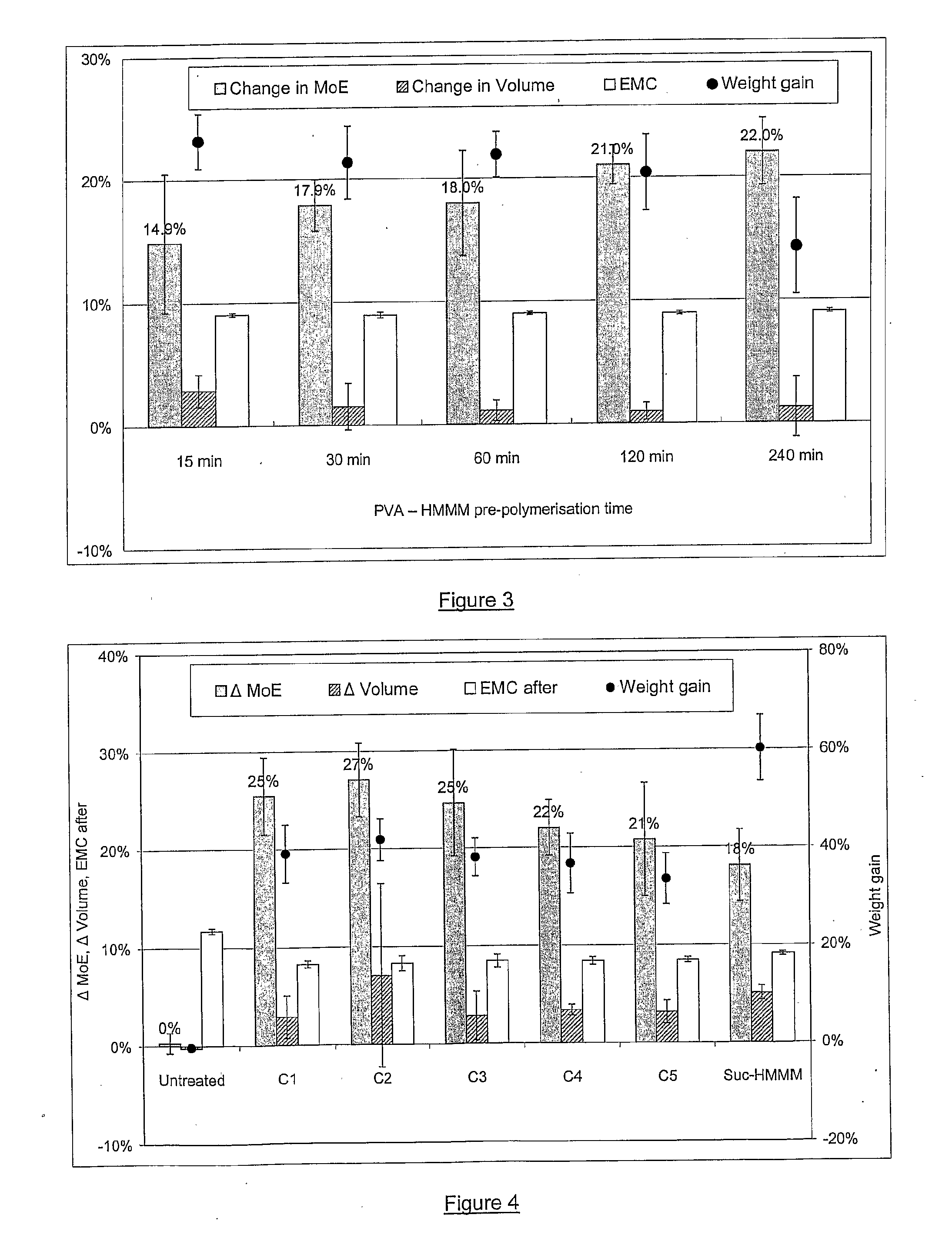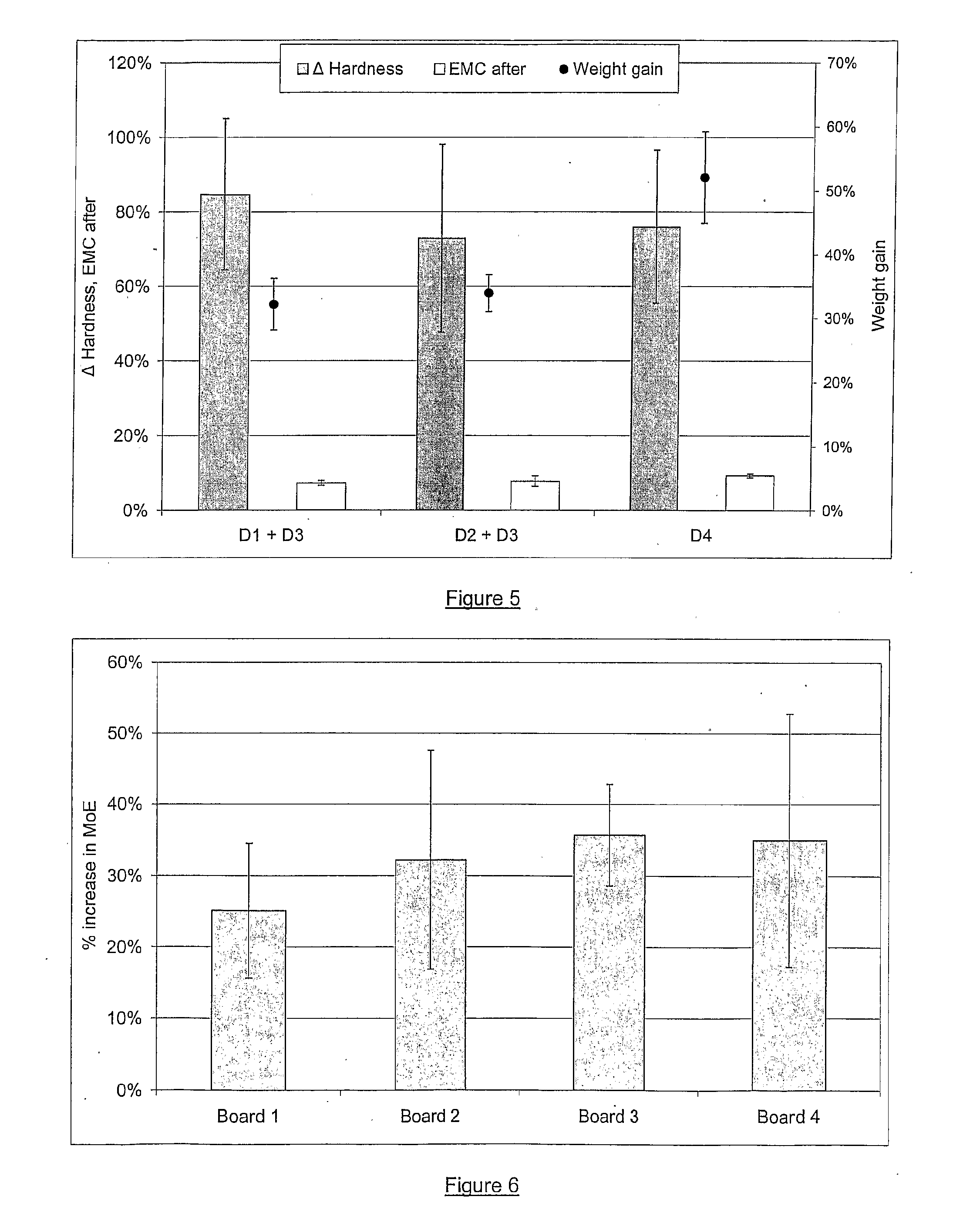Modification of wood with hydrophilic prepolymers
- Summary
- Abstract
- Description
- Claims
- Application Information
AI Technical Summary
Benefits of technology
Problems solved by technology
Method used
Image
Examples
example 1
[0168]Formulations A-C, each containing sucrose and hexamethoxymethyl melamine (HMMM) in a 2:1 ratio, combined with other ingredients, are given in Table 1. Sucrose and boric acid were dissolved in water. HMMM was mixed with ethanol then added, with stirring, to the aqueous phase. p-Toluene sulfonic acid (p-TSA) was omitted from Formulation A and a small amount of ammonium hydroxide was added to raise the pH >7.0. Surfynol 104A, containing a 50:50 mixture of Surfynol 104, an acetylenic dial surfactant, and 2-ethylhexanol, was added to complete the formulation. Ammonium hydroxide was added to Formulation B before p-TSA in order to prevent acid catalysis. Surfynol 104A was added to complete the formulation. To prepare Formulation C, sucrose and boric acid were dissolved in water then mixed with HMMM and ethanol in the stated proportions (Table 1), and pre-warmed to 25° C. p-TSA was then added to initiate prepolymerisation and the reaction mixture was maintained at 25° C. Aliquots of t...
example 2
[0176]Formulations A1-A6 containing PVA and HMMM in varying ratios, combined with other ingredients, are given in Table 2. An aqueous 20% (w / w) solution of PVA was mixed with HMMM and ethanol, and adjusted to 25° C. p-TSA was added to commence the crosslinking reaction. Ammonium hydroxide solution was added after 1 hour to terminate the reaction and raise the pH >7.0. Surfynol 104A was added after neutralisation.
TABLE 2Properties of PVA-HMMM formulations of varying composition.FormulationA1A2A3A4A5A6ComponentConcentration (g / kg)PVA (Poval 203)04080120160200HMMM20016012080400Ethanol20016012080400Water592632672712752794p-TSA444444NH4OH (25% v / v)222222Surfynol 104A222220PropertiesInitial pH7.697.737.847.967.797.90pH at 27 days4.414.294.124.415.436.40State at 27 daysClear liquidPowderyOpaqueOpaqueStrawStraw liquidprecipitatesolidsolidliquidpH at 64 days3.903.884.094.394.646.22State at 64 daysPolymerOpaqueOpaqueOpaqueOpaqueStraw liquidprecipitategelsolidsolidgel
[0177]Formulation A6 (PVA,...
example 3
[0179]Formulations with a PVA:HMMM ratio of 1.5:1.0 were prepared as described above. The crosslinking reaction was carried out at 25° C. for 15 to 240 minutes. As shown in Table 3 only formulations B1 to B3 from the crosslinking time course were in a liquid state 19 days post manufacture but all had solidified by 56 days.
TABLE 3Properties of PVA-HMMM formulations prepolymerised forincreasing times.FormulationB1B2B3B4B5PVA-HMMM pre-polymerisation time15 min30 min60 min120 min240 minComponentConcentration (g / kg)PVA (Poval 203)150150150150150HMMM100100100100100Ethanol100100100100100Water642642642642642p-TSA44444NH4OH (25% v / v)22222Surfynol 104A22222PropertiesInitial pH7.477.657.347.427.38pH at 19 days5.175.084.864.524.77State at 19 daysOpaqueOpaqueOpaqueStrongToughliquidliquidliquidgelwhitesolidpH at 56 days4.434.424.404.364.48State at 56 daysToughToughToughToughToughwhitewhitewhitewhitewhitesolidsolidsolidsolidsolid
[0180]Pinus radiata veneers were treated with formulations B1-B5 (Tab...
PUM
| Property | Measurement | Unit |
|---|---|---|
| Temperature | aaaaa | aaaaa |
| Temperature | aaaaa | aaaaa |
| Fraction | aaaaa | aaaaa |
Abstract
Description
Claims
Application Information
 Login to View More
Login to View More - R&D
- Intellectual Property
- Life Sciences
- Materials
- Tech Scout
- Unparalleled Data Quality
- Higher Quality Content
- 60% Fewer Hallucinations
Browse by: Latest US Patents, China's latest patents, Technical Efficacy Thesaurus, Application Domain, Technology Topic, Popular Technical Reports.
© 2025 PatSnap. All rights reserved.Legal|Privacy policy|Modern Slavery Act Transparency Statement|Sitemap|About US| Contact US: help@patsnap.com



